Changes in PRIMAP-hist v2.6.1_final compared to v2.6_final for Angola
2025-03-19
Johannes Gütschow
Change analysis for Angola for PRIMAP-hist v2.6.1_final compared to v2.6_final
Overview over emissions by sector and gas
The following figures show the aggregate national total emissions excluding LULUCF AR6GWP100 for the country reported priority scenario. The dotted linesshow the v2.6_final data.
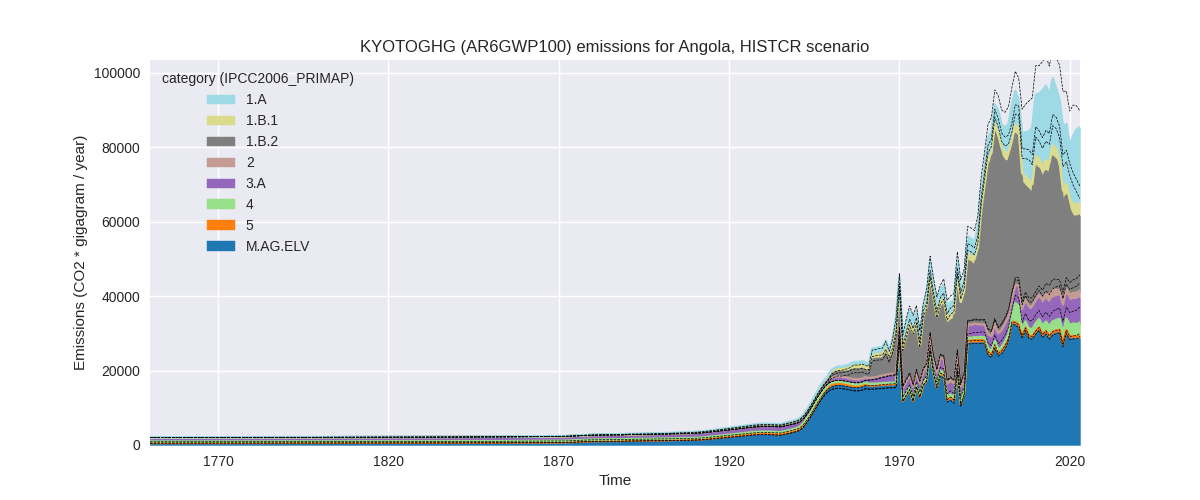
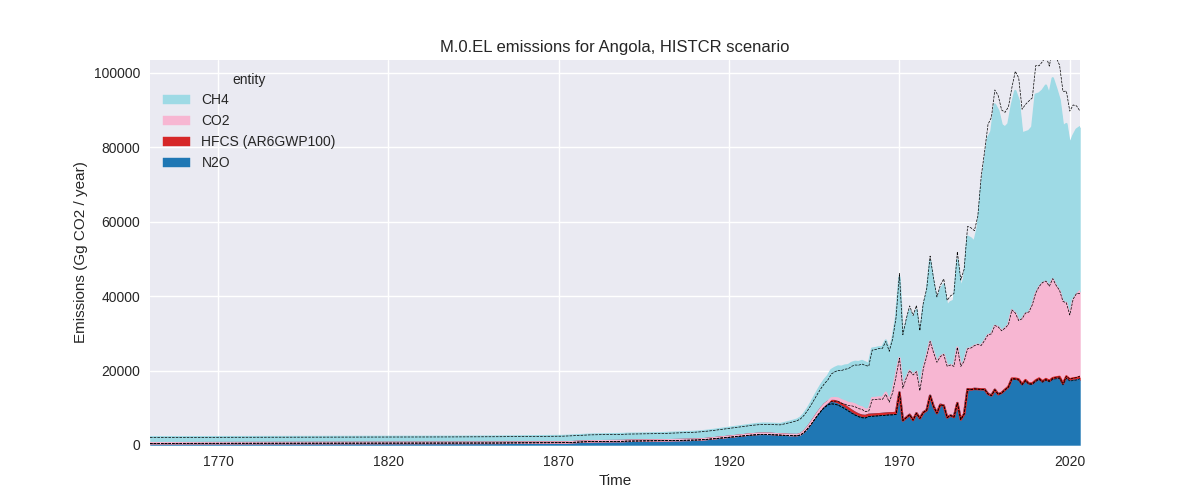
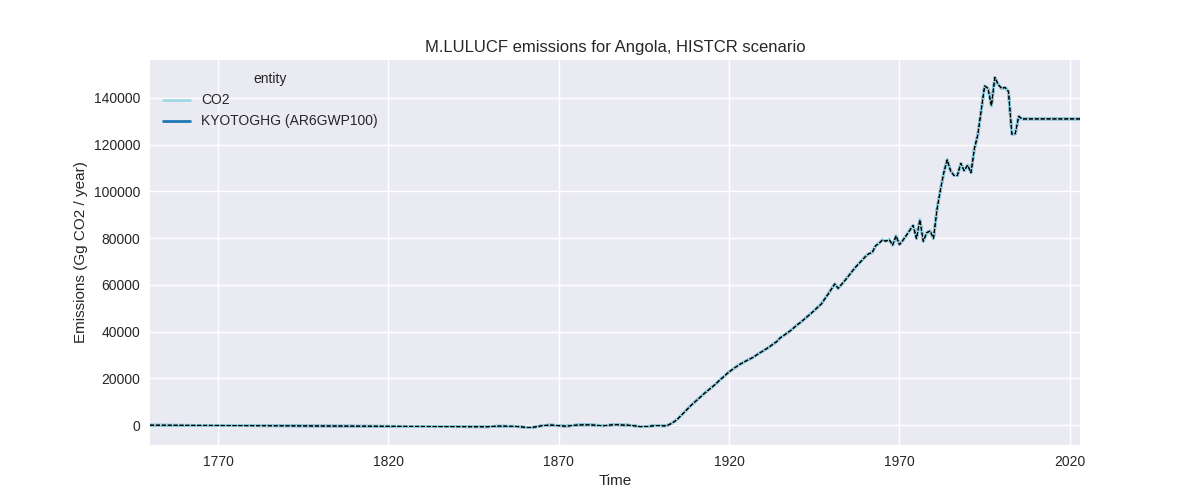
The following figures show the aggregate national total emissions excluding LULUCF AR6GWP100 for the third party priority scenario. The dotted linesshow the v2.6_final data.
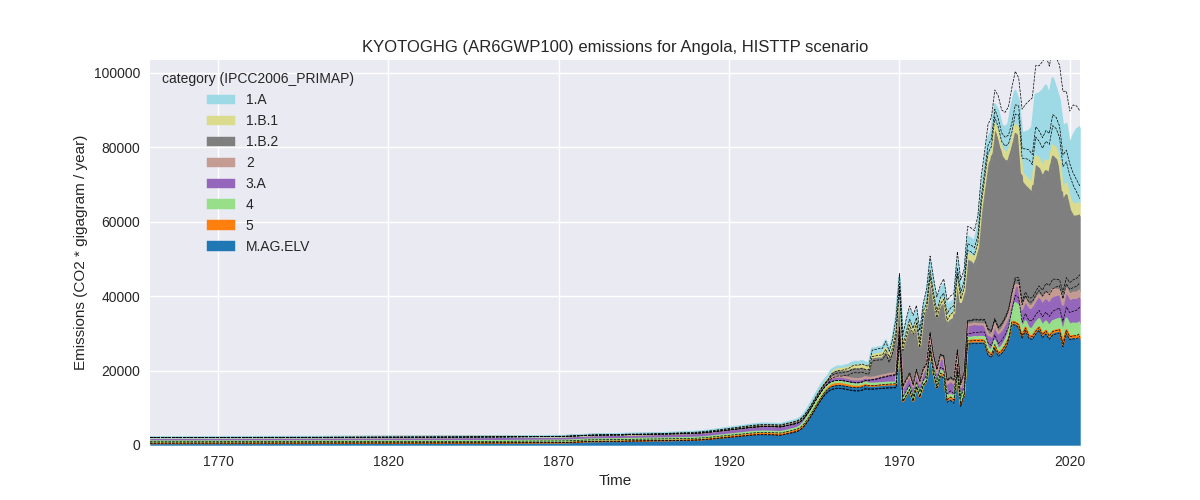
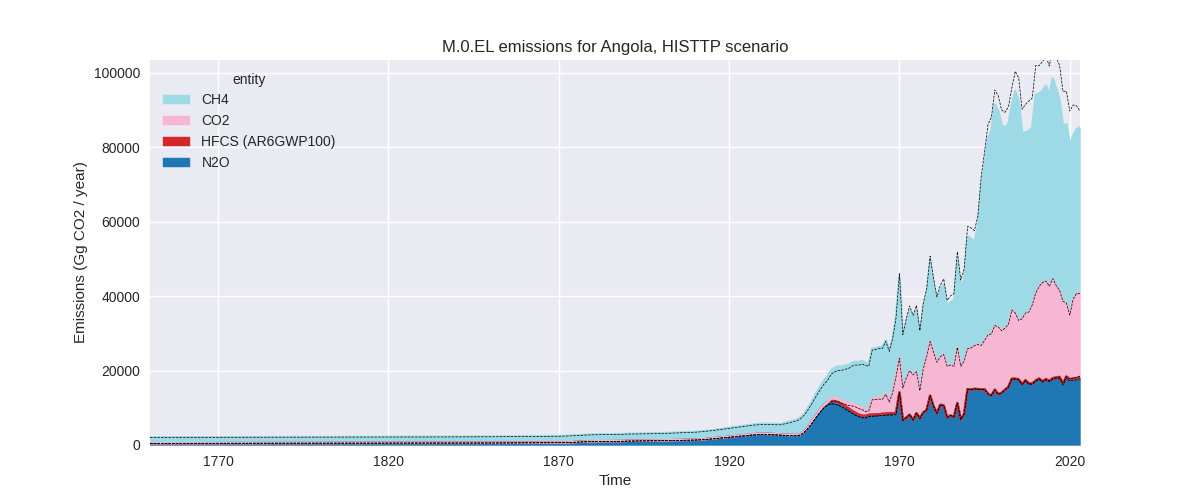
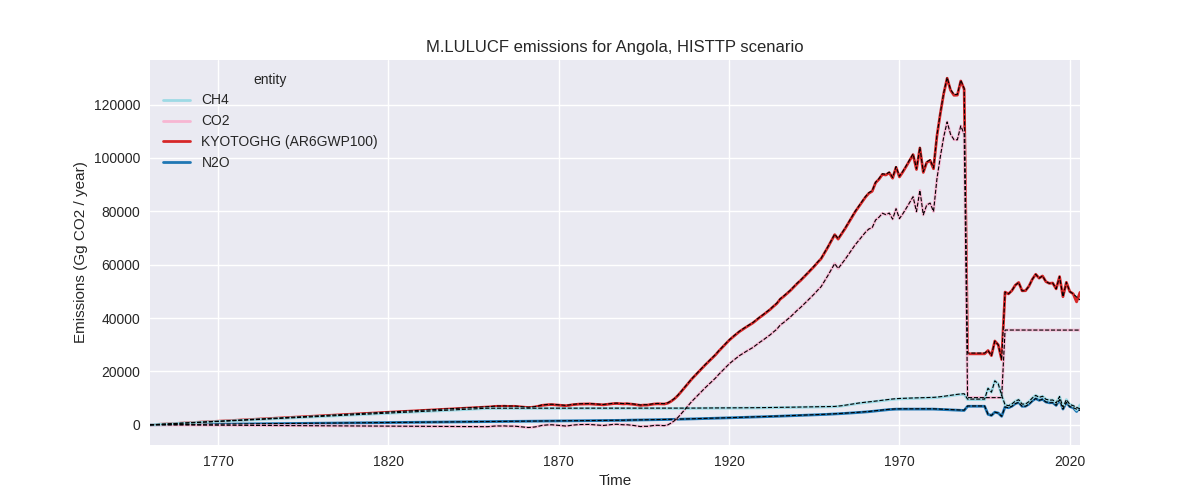
Overview over changes
In the country reported priority scenario we have the following changes for aggregate Kyoto GHG and national total emissions excluding LULUCF (M.0.EL):
- Emissions in 2023 have changed by -4.8%% (-4319.83 Gg CO2 / year)
- Emissions in 1990-2023 have changed by -6.7%% (-5997.95 Gg CO2 / year)
In the third party priority scenario we have the following changes for aggregate Kyoto GHG and national total emissions excluding LULUCF (M.0.EL):
- Emissions in 2023 have changed by -4.8%% (-4319.83 Gg CO2 / year)
- Emissions in 1990-2023 have changed by -6.7%% (-5997.95 Gg CO2 / year)
Most important changes per scenario and time frame
In the country reported priority scenario the following sector-gas combinations have the highest absolute impact on national total KyotoGHG (AR6GWP100) emissions in 2023 (top 5):
- 1: 4, CH4 with -3513.28 Gg CO2 / year (-52.2%)
- 2: 1.B.2, CH4 with -1262.20 Gg CO2 / year (-7.1%)
- 3: 1.B.2, CO2 with 1024.68 Gg CO2 / year (39.4%)
- 4: M.AG.ELV, CH4 with -342.71 Gg CO2 / year (-2.5%)
- 5: M.AG.ELV, N2O with -294.14 Gg CO2 / year (-1.9%)
In the country reported priority scenario the following sector-gas combinations have the highest absolute impact on national total KyotoGHG (AR6GWP100) emissions in 1990-2023 (top 5):
- 1: 1.B.2, CH4 with -3718.09 Gg CO2 / year (-13.1%)
- 2: 4, CH4 with -2186.99 Gg CO2 / year (-53.3%)
- 3: 1.B.2, CO2 with -107.48 Gg CO2 / year (-1.3%)
- 4: 1.A, CH4 with 36.26 Gg CO2 / year (2.7%)
- 5: 1.B.1, CH4 with 17.60 Gg CO2 / year (0.7%)
In the third party priority scenario the following sector-gas combinations have the highest absolute impact on national total KyotoGHG (AR6GWP100) emissions in 2023 (top 5):
- 1: 4, CH4 with -3513.28 Gg CO2 / year (-52.2%)
- 2: 1.B.2, CH4 with -1262.20 Gg CO2 / year (-7.1%)
- 3: 1.B.2, CO2 with 1024.68 Gg CO2 / year (39.4%)
- 4: M.AG.ELV, CH4 with -342.71 Gg CO2 / year (-2.5%)
- 5: M.AG.ELV, N2O with -294.14 Gg CO2 / year (-1.9%)
In the third party priority scenario the following sector-gas combinations have the highest absolute impact on national total KyotoGHG (AR6GWP100) emissions in 1990-2023 (top 5):
- 1: 1.B.2, CH4 with -3718.09 Gg CO2 / year (-13.1%)
- 2: 4, CH4 with -2186.99 Gg CO2 / year (-53.3%)
- 3: 1.B.2, CO2 with -107.48 Gg CO2 / year (-1.3%)
- 4: 1.A, CH4 with 36.26 Gg CO2 / year (2.7%)
- 5: 1.B.1, CH4 with 17.60 Gg CO2 / year (0.7%)
Notes on data changes
Here we list notes explaining important emissions changes for the country.
- We have no usable country reported data for Angola and CR and TP time-series are the same.
- Lower emissions in 2023 and cumulatively are due to lower Waste CH4 emissions and fugitive CH4 emissions (both from EDGAR)
- Fugitive CO2 is higher for 2023 and slightly lower for cumulative emissions (from EDGAR)
- Agricultural emissions have a small change for the latest years (from FAOSTAT)
Changes by sector and gas
For each scenario and time frame the changes are displayed for all individual sectors and all individual gases. In the sector plot we use aggregate Kyoto GHGs in AR6GWP100. In the gas plot we usenational total emissions without LULUCF.
country reported scenario
2023
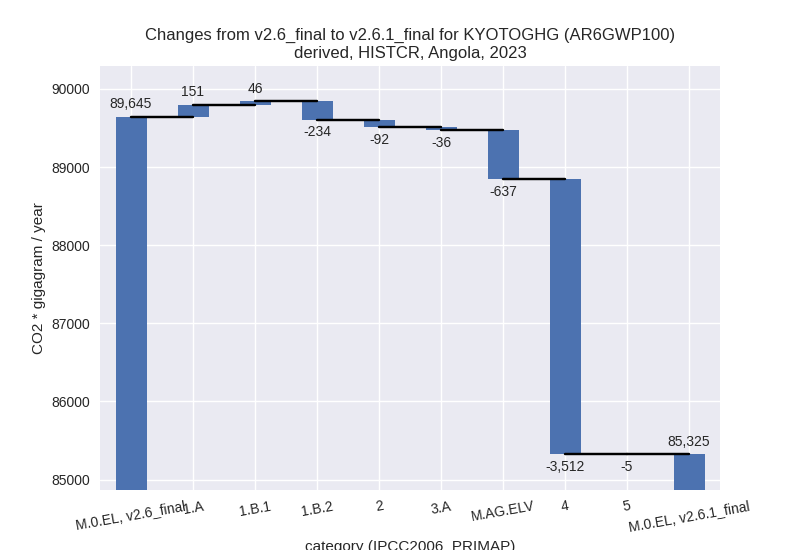
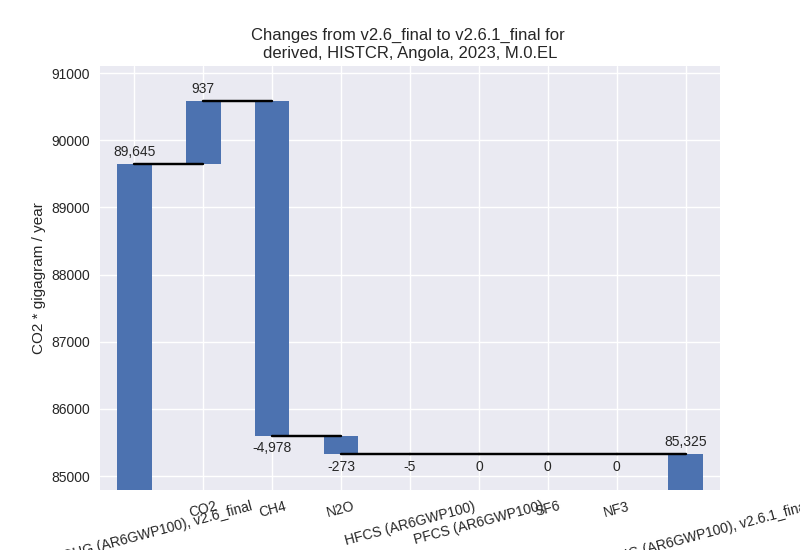
1990-2023
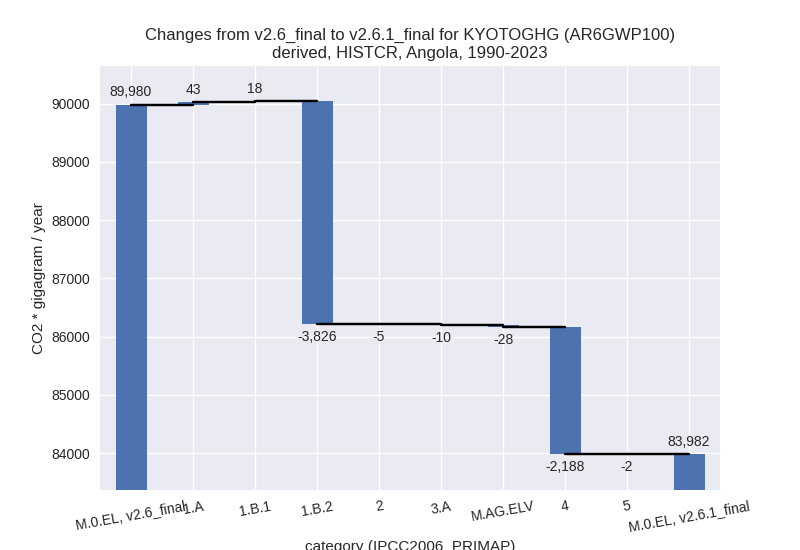
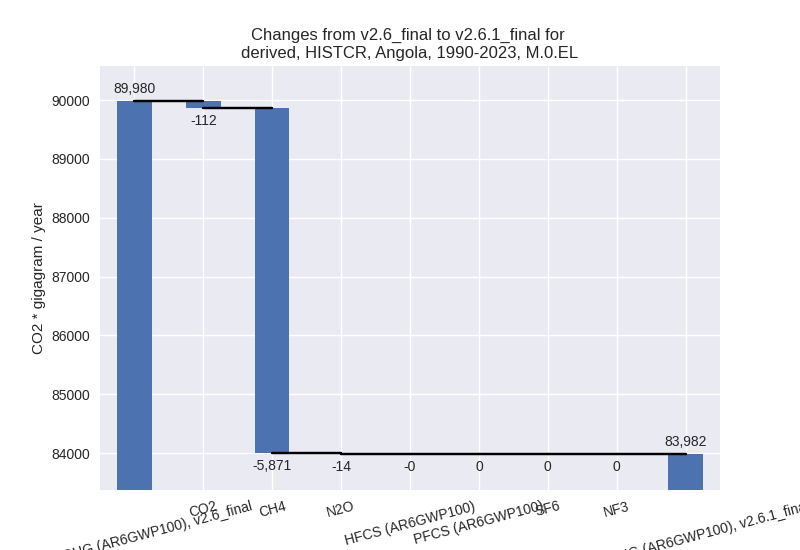
third party scenario
2023
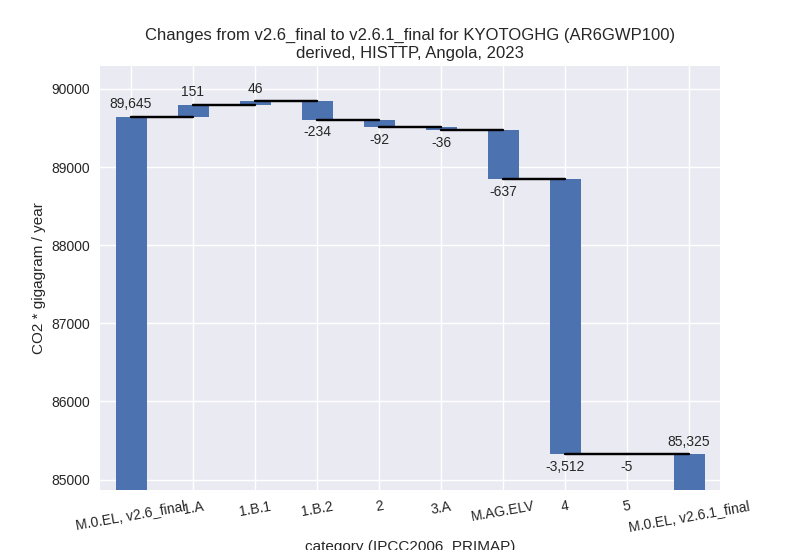
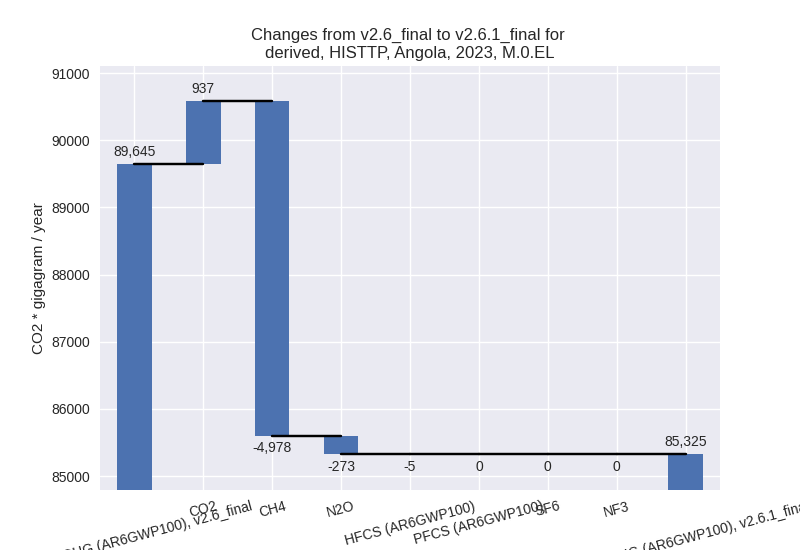
1990-2023
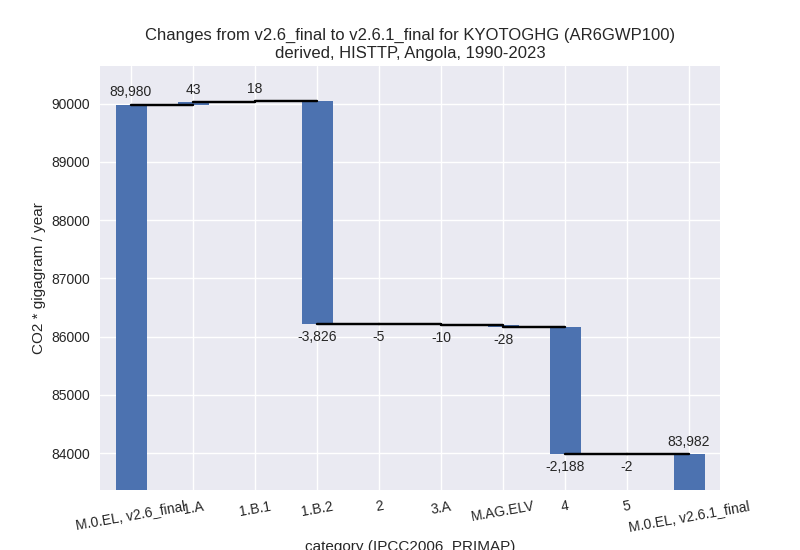
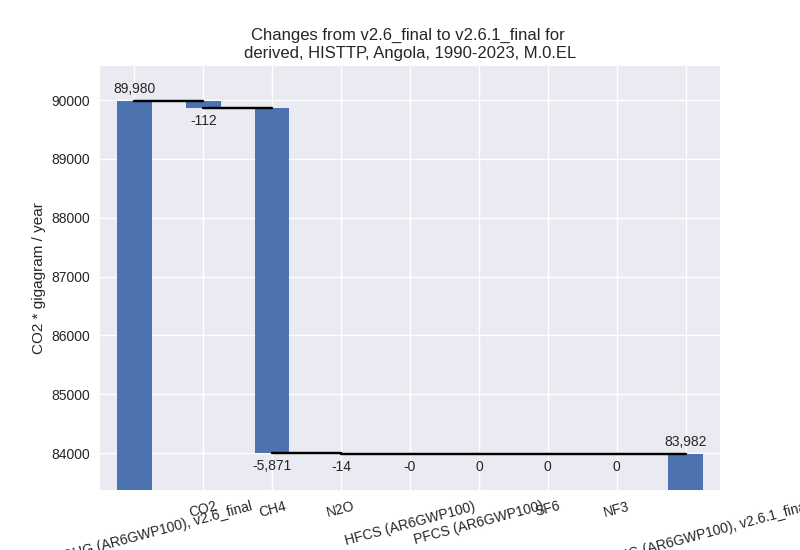
Detailed changes for the scenarios:
country reported scenario (HISTCR):
Most important changes per time frame
For 2023 the following sector-gas combinations have the highest absolute impact on national total KyotoGHG (AR6GWP100) emissions in 2023 (top 5):
- 1: 4, CH4 with -3513.28 Gg CO2 / year (-52.2%)
- 2: 1.B.2, CH4 with -1262.20 Gg CO2 / year (-7.1%)
- 3: 1.B.2, CO2 with 1024.68 Gg CO2 / year (39.4%)
- 4: M.AG.ELV, CH4 with -342.71 Gg CO2 / year (-2.5%)
- 5: M.AG.ELV, N2O with -294.14 Gg CO2 / year (-1.9%)
For 1990-2023 the following sector-gas combinations have the highest absolute impact on national total KyotoGHG (AR6GWP100) emissions in 1990-2023 (top 5):
- 1: 1.B.2, CH4 with -3718.09 Gg CO2 / year (-13.1%)
- 2: 4, CH4 with -2186.99 Gg CO2 / year (-53.3%)
- 3: 1.B.2, CO2 with -107.48 Gg CO2 / year (-1.3%)
- 4: 1.A, CH4 with 36.26 Gg CO2 / year (2.7%)
- 5: 1.B.1, CH4 with 17.60 Gg CO2 / year (0.7%)
Changes in the main sectors for aggregate KyotoGHG (AR6GWP100) are
- 1: Total sectoral emissions in 2022 are 43798.89 Gg
CO2 / year which is 51.7% of M.0.EL emissions. 2023 Emissions have
changed by -0.1% (-36.99 Gg CO2 /
year). 1990-2023 Emissions have changed by -7.4% (-3765.96 Gg CO2 / year). For
1990-2023 the changes per gas
are:
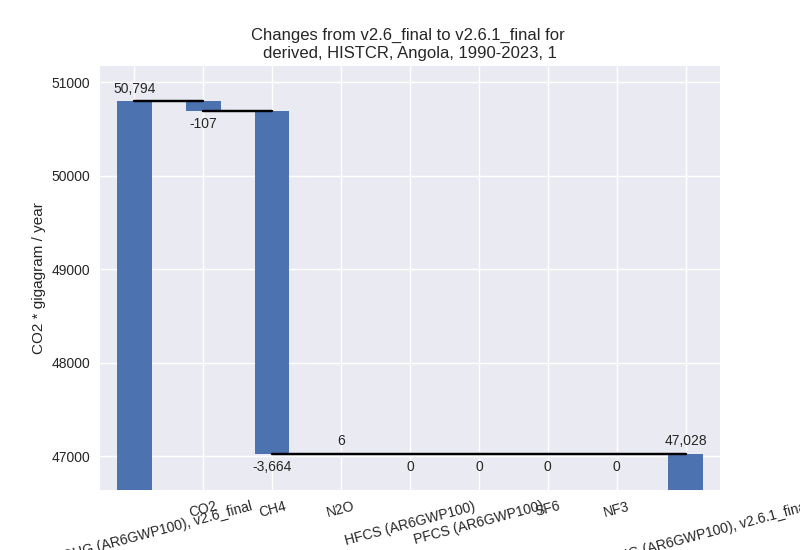
The changes come from the following subsectors:- 1.A: Total sectoral emissions in 2022 are 20014.45 Gg CO2 / year which is 45.7% of category 1 emissions. 2023 Emissions have changed by 0.7% (150.99 Gg CO2 / year). 1990-2023 Emissions have changed by 0.4% (42.54 Gg CO2 / year).
- 1.B.1: Total sectoral emissions in 2022 are 3380.33 Gg CO2 / year which is 7.7% of category 1 emissions. 2023 Emissions have changed by 1.4% (45.81 Gg CO2 / year). 1990-2023 Emissions have changed by 0.7% (17.83 Gg CO2 / year).
- 1.B.2: Total sectoral emissions in 2022 are
20404.11 Gg CO2 / year which is 46.6% of category 1 emissions. 2023
Emissions have changed by -1.1%
(-233.80 Gg CO2 / year). 1990-2023 Emissions have changed by -10.5% (-3826.33 Gg CO2 / year). For
1990-2023 the changes per gas
are:
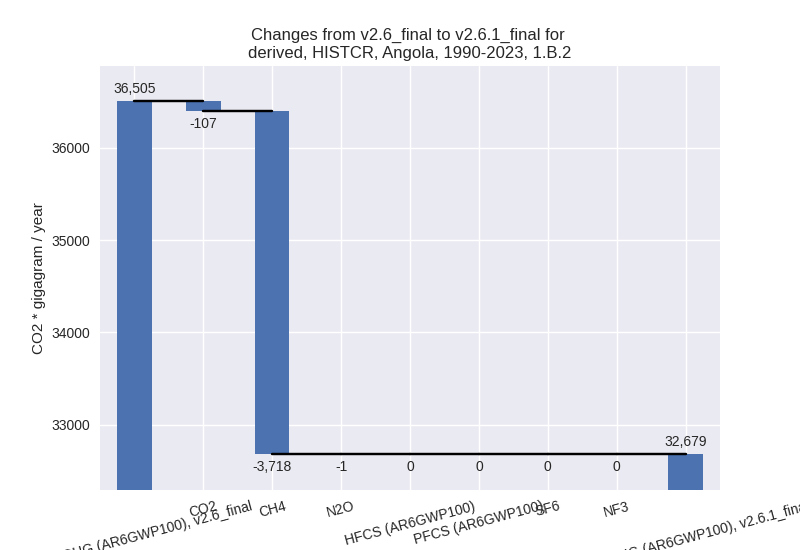
There is no subsector information available in PRIMAP-hist.
- 2: Total sectoral emissions in 2022 are 2040.94 Gg
CO2 / year which is 2.4% of M.0.EL emissions. 2023 Emissions have
changed by -4.2% (-92.45 Gg CO2 /
year). 1990-2023 Emissions have changed by -0.4% (-4.66 Gg CO2 / year). For 2023 the
changes per gas
are:
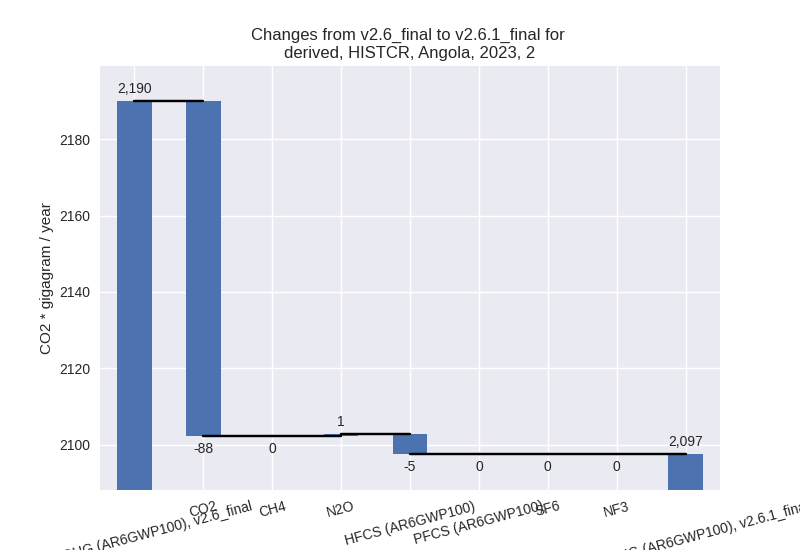
- M.AG: Total sectoral emissions in 2022 are 34565.44 Gg CO2 / year which is 40.8% of M.0.EL emissions. 2023 Emissions have changed by -1.9% (-673.22 Gg CO2 / year). 1990-2023 Emissions have changed by -0.1% (-37.98 Gg CO2 / year).
- 4: Total sectoral emissions in 2022 are 3422.12 Gg
CO2 / year which is 4.0% of M.0.EL emissions. 2023 Emissions have
changed by -49.9% (-3512.27 Gg CO2 /
year). 1990-2023 Emissions have changed by -51.2% (-2187.84 Gg CO2 / year). For 2023
the changes per gas
are:
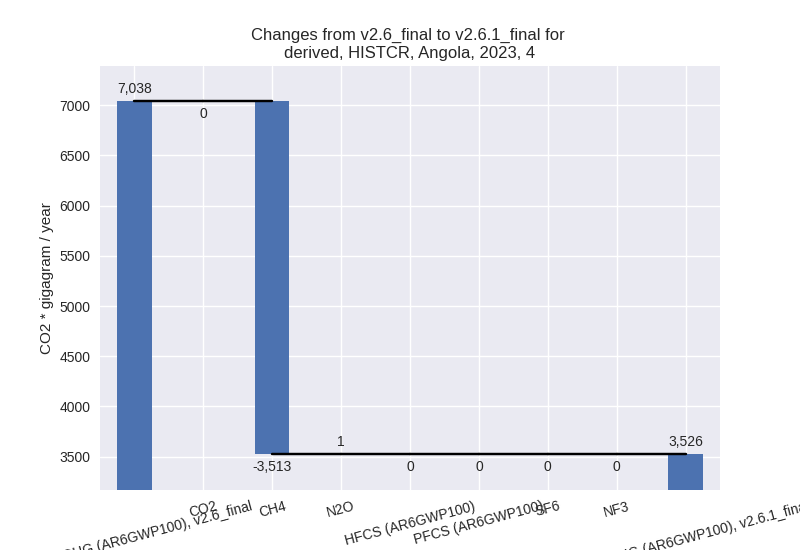
For 1990-2023 the changes per gas are: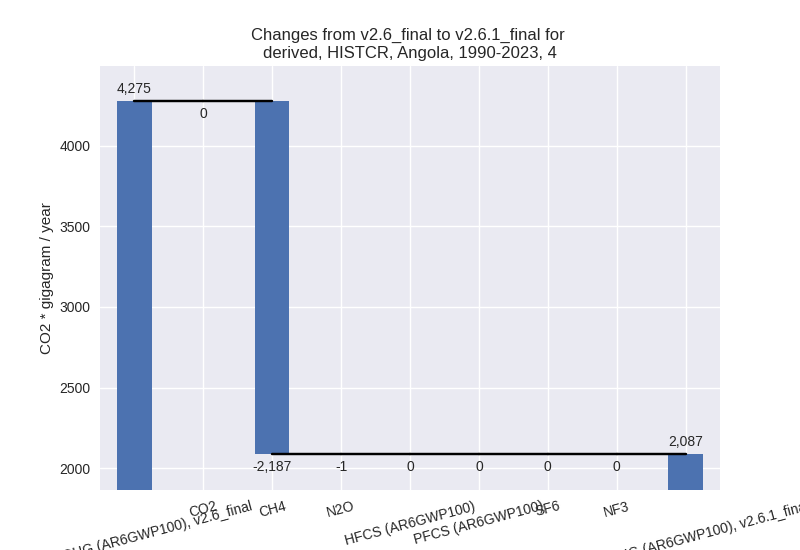
- 5: Total sectoral emissions in 2022 are 859.35 Gg CO2 / year which is 1.0% of M.0.EL emissions. 2023 Emissions have changed by -0.6% (-4.90 Gg CO2 / year). 1990-2023 Emissions have changed by -0.2% (-1.52 Gg CO2 / year).
third party scenario (HISTTP):
Most important changes per time frame
For 2023 the following sector-gas combinations have the highest absolute impact on national total KyotoGHG (AR6GWP100) emissions in 2023 (top 5):
- 1: 4, CH4 with -3513.28 Gg CO2 / year (-52.2%)
- 2: 1.B.2, CH4 with -1262.20 Gg CO2 / year (-7.1%)
- 3: 1.B.2, CO2 with 1024.68 Gg CO2 / year (39.4%)
- 4: M.AG.ELV, CH4 with -342.71 Gg CO2 / year (-2.5%)
- 5: M.AG.ELV, N2O with -294.14 Gg CO2 / year (-1.9%)
For 1990-2023 the following sector-gas combinations have the highest absolute impact on national total KyotoGHG (AR6GWP100) emissions in 1990-2023 (top 5):
- 1: 1.B.2, CH4 with -3718.09 Gg CO2 / year (-13.1%)
- 2: 4, CH4 with -2186.99 Gg CO2 / year (-53.3%)
- 3: 1.B.2, CO2 with -107.48 Gg CO2 / year (-1.3%)
- 4: 1.A, CH4 with 36.26 Gg CO2 / year (2.7%)
- 5: 1.B.1, CH4 with 17.60 Gg CO2 / year (0.7%)
Changes in the main sectors for aggregate KyotoGHG (AR6GWP100) are
- 1: Total sectoral emissions in 2022 are 43798.89 Gg
CO2 / year which is 51.7% of M.0.EL emissions. 2023 Emissions have
changed by -0.1% (-36.99 Gg CO2 /
year). 1990-2023 Emissions have changed by -7.4% (-3765.96 Gg CO2 / year). For
1990-2023 the changes per gas
are:
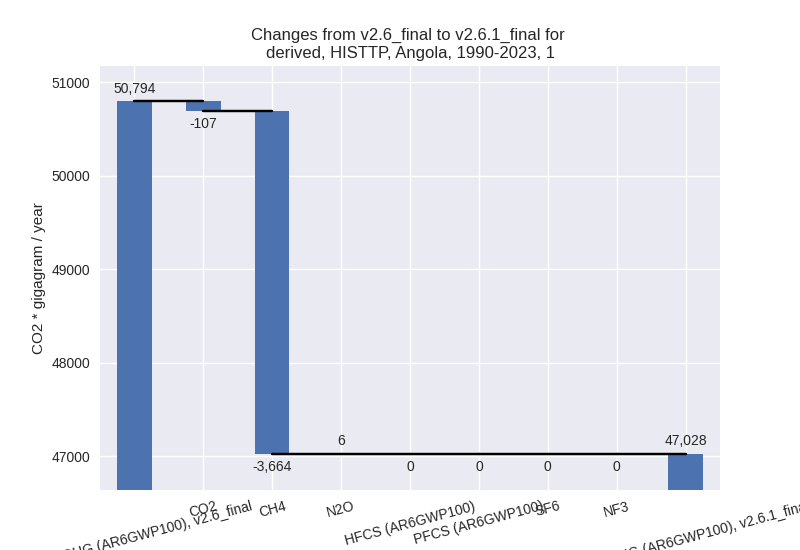
The changes come from the following subsectors:- 1.A: Total sectoral emissions in 2022 are 20014.45 Gg CO2 / year which is 45.7% of category 1 emissions. 2023 Emissions have changed by 0.7% (150.99 Gg CO2 / year). 1990-2023 Emissions have changed by 0.4% (42.54 Gg CO2 / year).
- 1.B.1: Total sectoral emissions in 2022 are 3380.33 Gg CO2 / year which is 7.7% of category 1 emissions. 2023 Emissions have changed by 1.4% (45.81 Gg CO2 / year). 1990-2023 Emissions have changed by 0.7% (17.83 Gg CO2 / year).
- 1.B.2: Total sectoral emissions in 2022 are
20404.11 Gg CO2 / year which is 46.6% of category 1 emissions. 2023
Emissions have changed by -1.1%
(-233.80 Gg CO2 / year). 1990-2023 Emissions have changed by -10.5% (-3826.33 Gg CO2 / year). For
1990-2023 the changes per gas
are:
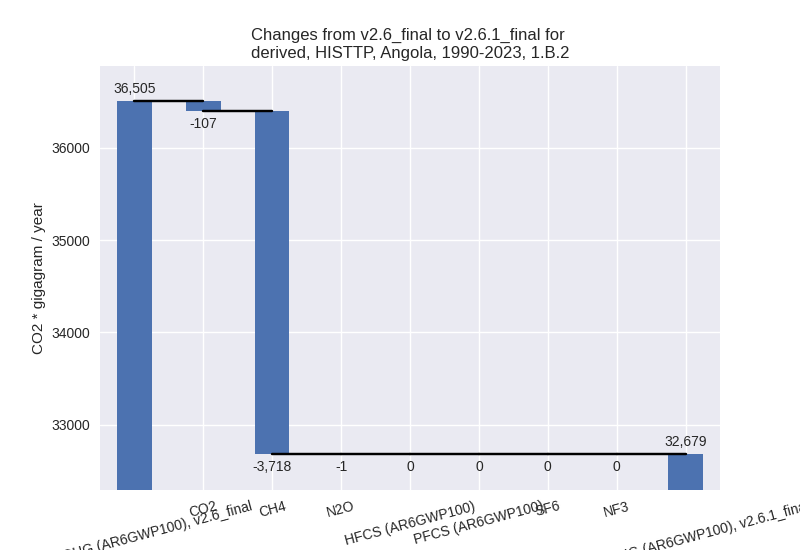
There is no subsector information available in PRIMAP-hist.
- 2: Total sectoral emissions in 2022 are 2040.94 Gg
CO2 / year which is 2.4% of M.0.EL emissions. 2023 Emissions have
changed by -4.2% (-92.45 Gg CO2 /
year). 1990-2023 Emissions have changed by -0.4% (-4.66 Gg CO2 / year). For 2023 the
changes per gas
are:
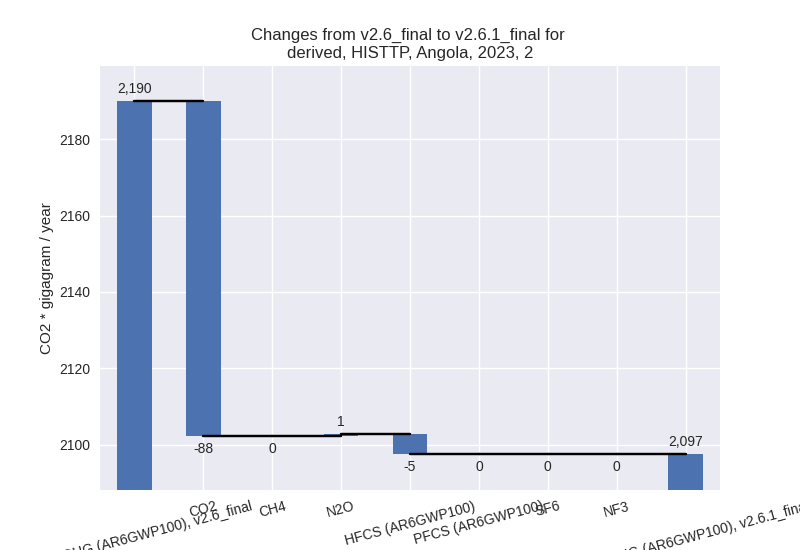
- M.AG: Total sectoral emissions in 2022 are 34565.44 Gg CO2 / year which is 40.8% of M.0.EL emissions. 2023 Emissions have changed by -1.9% (-673.22 Gg CO2 / year). 1990-2023 Emissions have changed by -0.1% (-37.98 Gg CO2 / year).
- 4: Total sectoral emissions in 2022 are 3422.12 Gg
CO2 / year which is 4.0% of M.0.EL emissions. 2023 Emissions have
changed by -49.9% (-3512.27 Gg CO2 /
year). 1990-2023 Emissions have changed by -51.2% (-2187.84 Gg CO2 / year). For 2023
the changes per gas
are:
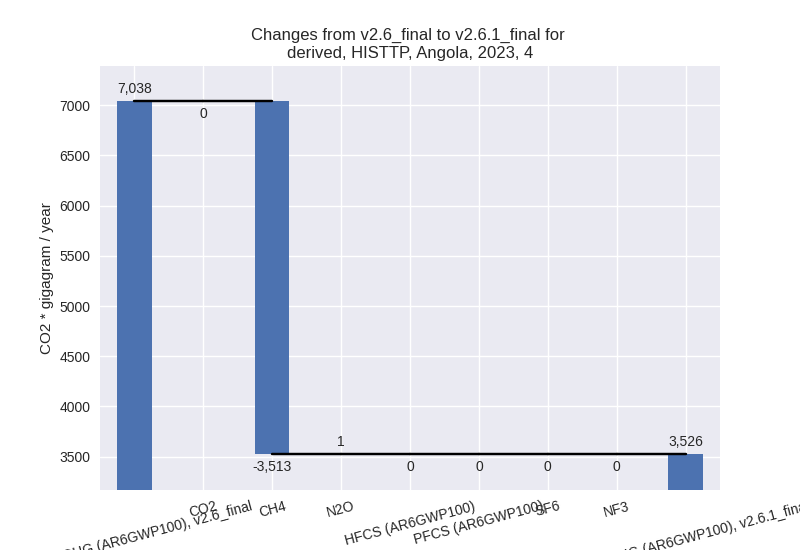
For 1990-2023 the changes per gas are: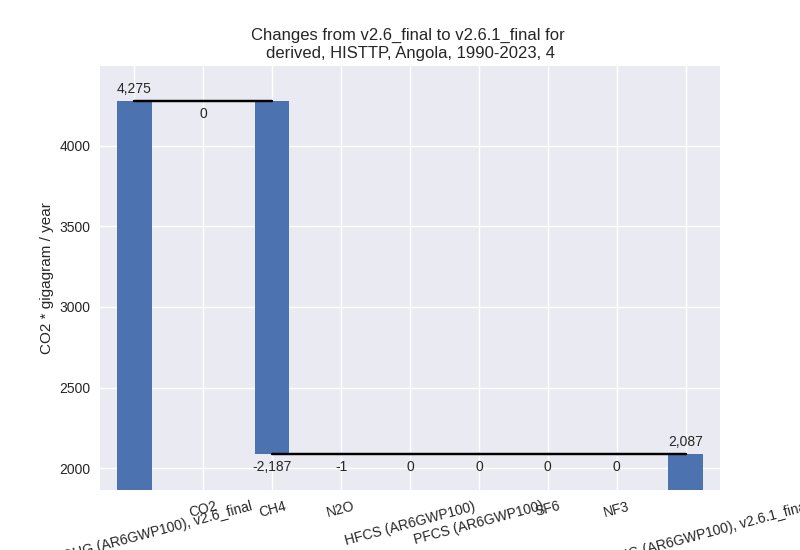
- 5: Total sectoral emissions in 2022 are 859.35 Gg CO2 / year which is 1.0% of M.0.EL emissions. 2023 Emissions have changed by -0.6% (-4.90 Gg CO2 / year). 1990-2023 Emissions have changed by -0.2% (-1.52 Gg CO2 / year).